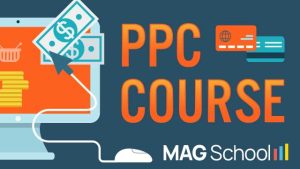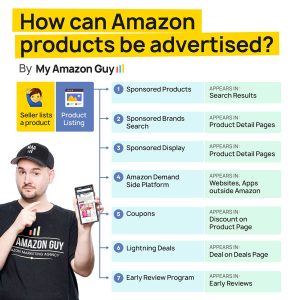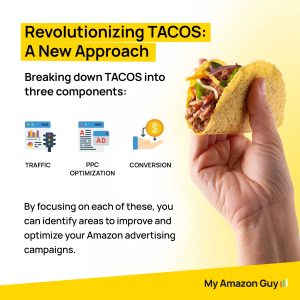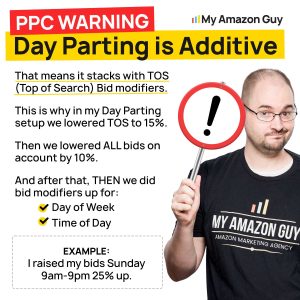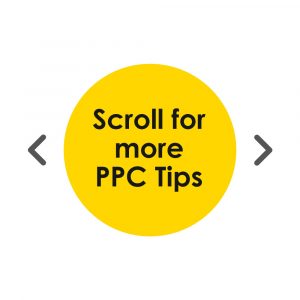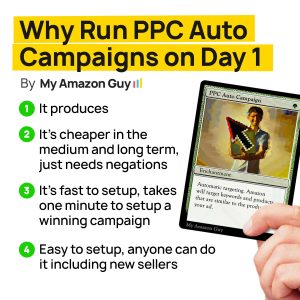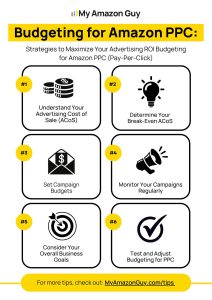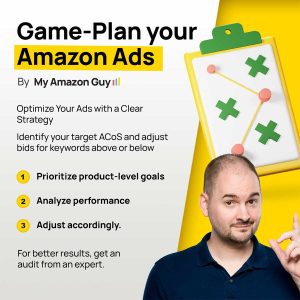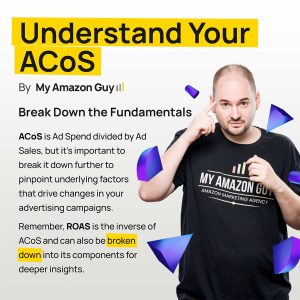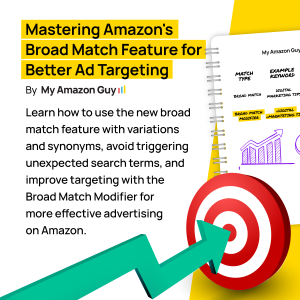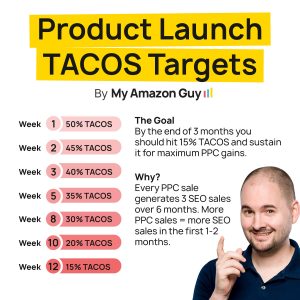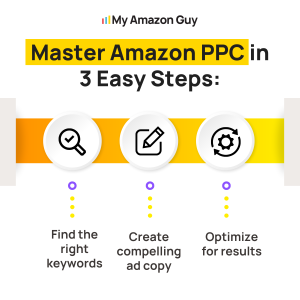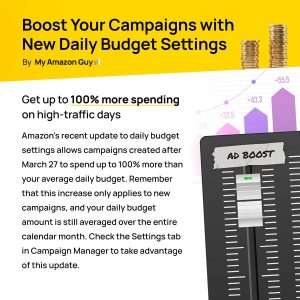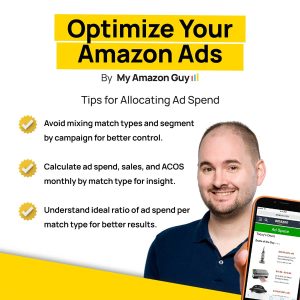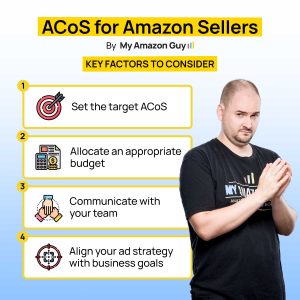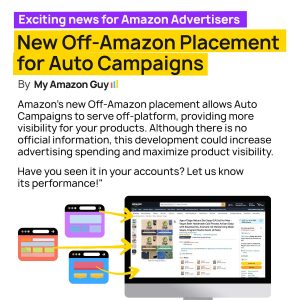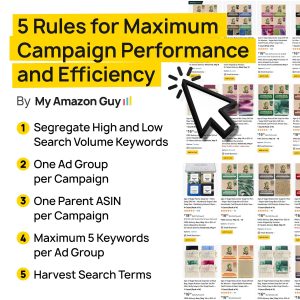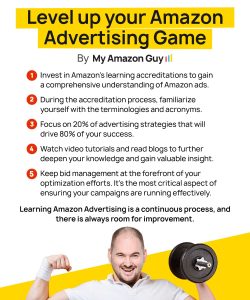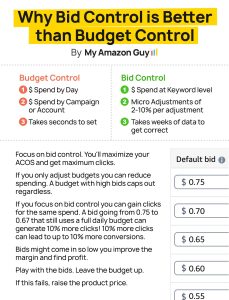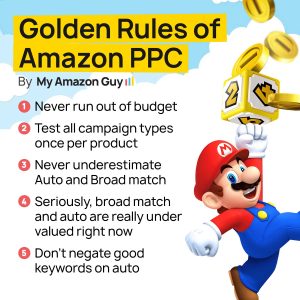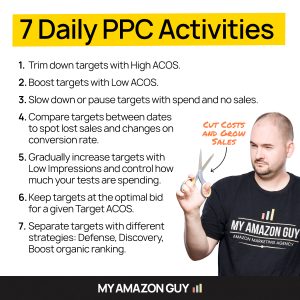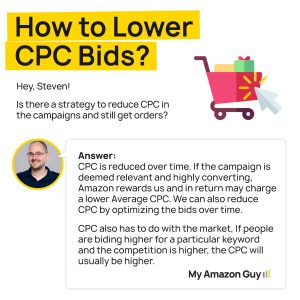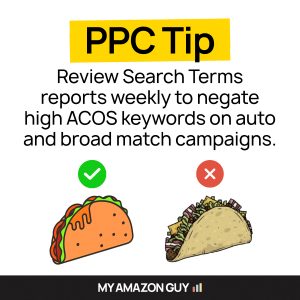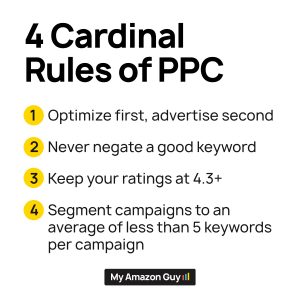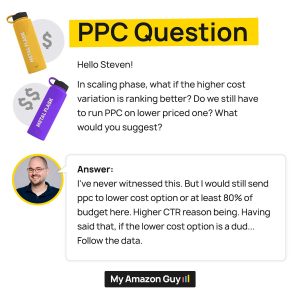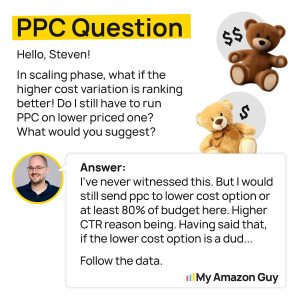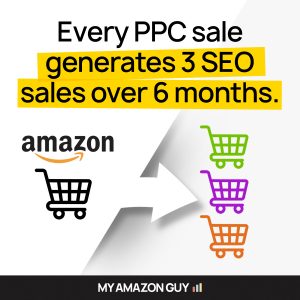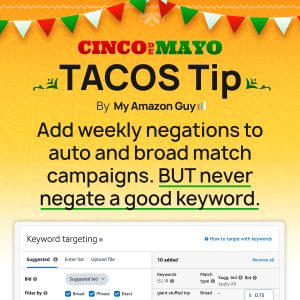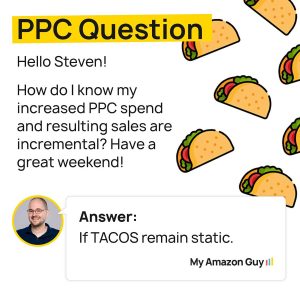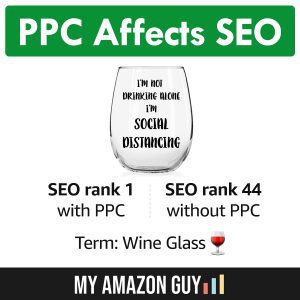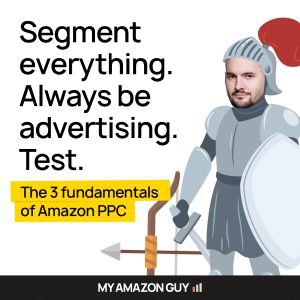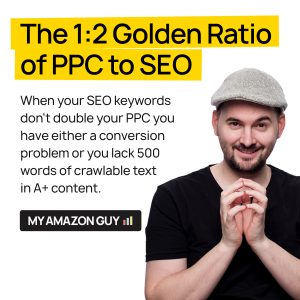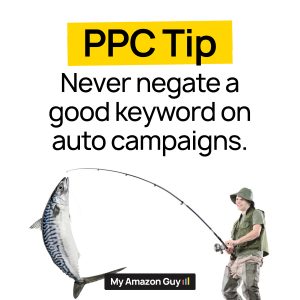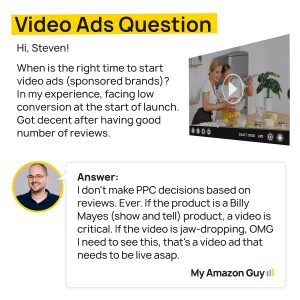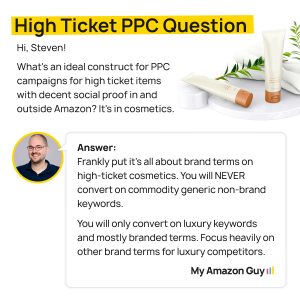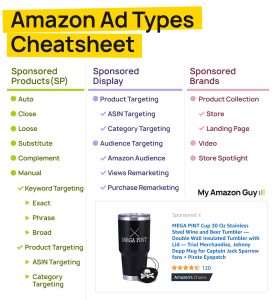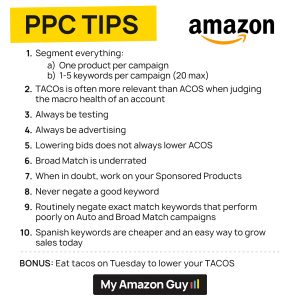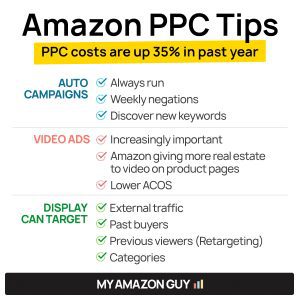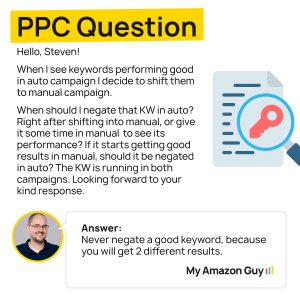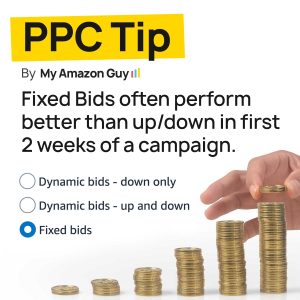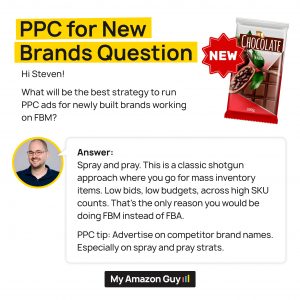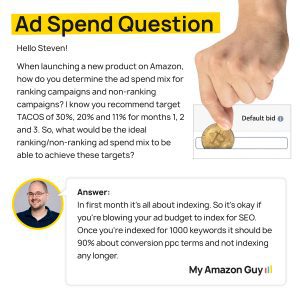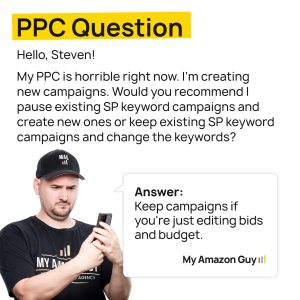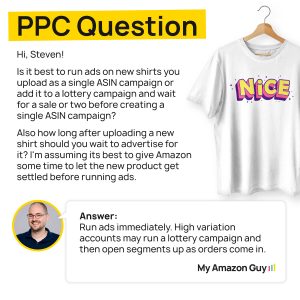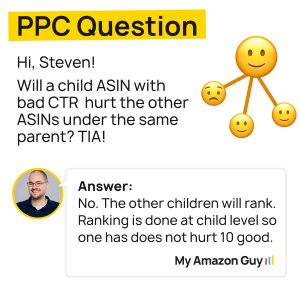Lower PPC ACOS
In this video, watch our CEO Steven Pope give a masterclass on PPC to learn the best practices for more effective PPC campaigns and lowering your ACOS (Advertising Cost of Sales).
Take the MAG School PPC Course
Learn how to structure, monitor, and optimize your paid advertising to maximize growth and profitability. Enroll Now
PPC Frequently Asked Question
How do I improve my PPC ads?
To improve PPC ads as an Amazon expert, one should focus on several key areas. Firstly, it is important to ensure that the ad copy is compelling and relevant to the product being advertised. This involves highlighting the product’s unique features and benefits and using strong calls to action to encourage clicks. Additionally, incorporating positive customer reviews and using high-quality product images can increase credibility and persuade potential customers to click on the ad.
Another crucial factor in improving PPC ads is targeting the right audience. Utilizing Amazon’s targeting options, such as keywords, product categories, and customer behavior, can ensure that the ad is reaching the right people. Bid optimization is also crucial for achieving a high return on investment (ROI), and should be continuously monitored and adjusted as needed. Finally, regularly monitor campaign performance and experiment with different strategies, such as different ad formats and bidding strategies.
5 Amazon PPC Hacks
Steven Pope discusses five Amazon PPC Hacks that you can do in under 5 minutes to help improve the performance of your ads.
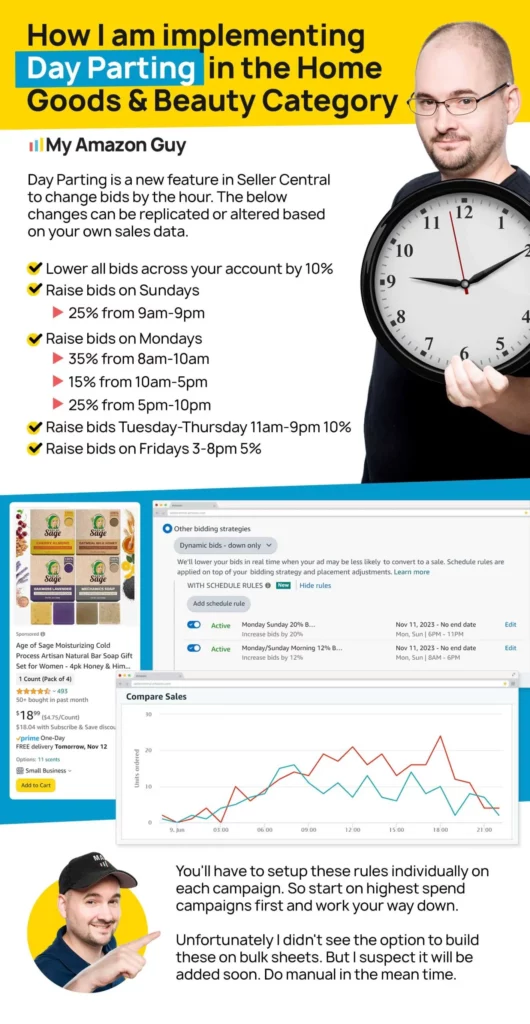
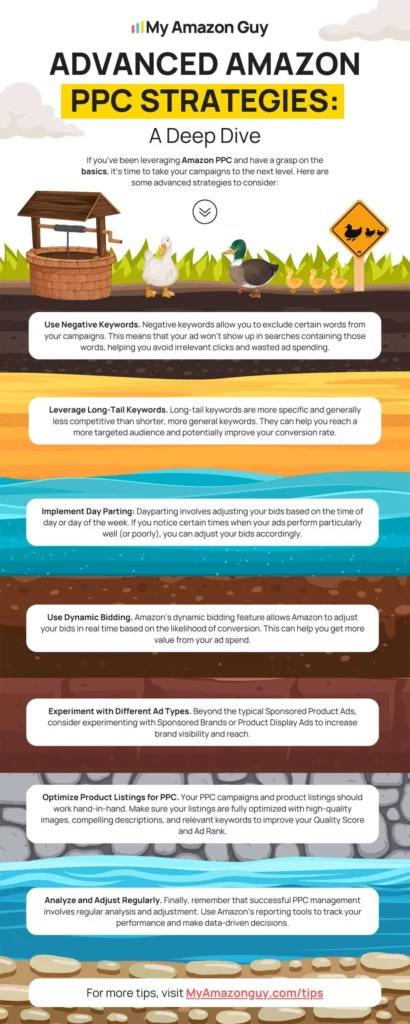
Improve Search Rankings
Increase Conversion Rate
Tell Your Brand Story
Showcase Multiple Products
PPC Frequently Asked Question
What is a good CTR in Amazon PPC?
As an Amazon expert, what constitutes a good click-through rate (CTR) can vary depending on several factors such as product category, competition, and bidding strategy. Generally, a CTR of around 0.5% to 1% can be considered good on Amazon.
However, it is important to note that CTR should not be the sole metric for measuring the success of a PPC campaign, as conversion rates and return on ad spend (ROAS) are equally important. It is also important to continuously monitor and optimize campaigns to improve performance over time, and to make data-driven decisions based on campaign metrics. Advertisers should strive to achieve a balance between clicks and conversions, ensuring that their ads are generating quality traffic and ultimately driving sales. Ultimately, what constitutes a good CTR on Amazon depends on the specific goals and objectives of the campaign and the competitive landscape in which it is operating.
$87 Spend $1000 Monthly Revenue with PPC Hack, Coaching Testimonial of My Amazon Guy

What they say about our Amazon Agency
Here’s what our customers have to say.

Amazon Accredited Advertising
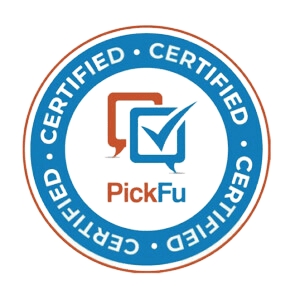
PickFu Certified

Helium 10 Trusted Partner

“Hi Steven! Big fan of all the PPC/AMazon content that you put out”
~ Luke Basha
“Thank you all SO much for your desire to get this completed to levels beyond our satisfaction. It’s so impressive to me that you all, including the designer, didn’t stop until it was right.”
~ Patrick Shannon
Sprinkle & Sweep

Want to be a guest on our PPC AMA? Apply here!
As an Amazon advertising agency, we host a weekly YouTube live show where we answer questions from Amazon sellers and share expert advice on Amazon PPC—all for free. Join our own Kevin Sanderson as a guest host, and let’s tackle Amazon seller challenges together!
Make it easier for customers to find your listing with better Amazon SEO
Lear how to use Amazon SEO to help optimize your product listings and rank better in product searches.
Frequently Asked Questions
Optimizing your product listing is the first step to increasing your PPC campaigns. This includes creating a clear and concise product title, writing a compelling product description, and using high-quality images that showcase your product’s features. Conduct thorough keyword research to identify your product’s most relevant and high-traffic keywords. Incorporate these keywords into your product listing and ad campaigns to increase your visibility and relevance. Bid optimization is also a crucial component of successful PPC campaigns. Start by analyzing your ad performance and adjusting your bids accordingly to ensure you are maximizing your ROI. Create ad groups based on the keywords you are targeting to customize your ad copy and bidding strategy for each group, increasing the relevance of your ads and improving their performance.
To improve PPC ads as an Amazon expert, one should focus on several key areas. Firstly, it is important to ensure that the ad copy is compelling and relevant to the product being advertised. This involves highlighting the product’s unique features and benefits and using strong calls to action to encourage clicks. Additionally, incorporating positive customer reviews and using high-quality product images can increase credibility and persuade potential customers to click on the ad. Another crucial factor in improving PPC ads is targeting the right audience. Utilizing Amazon’s targeting options, such as keywords, product categories, and customer behavior, can ensure that the ad is reaching the right people. Bid optimization is also crucial for achieving a high return on investment (ROI), and should be continuously monitored and adjusted as needed. Finally, regularly monitor campaign performance and experiment with different strategies, such as different ad formats and bidding strategies.
The best PPC strategies to use depend on the specific products being advertised and the target audience. Some effective strategies include:
Targeted keyword optimization: Identifying and incorporating high-traffic and relevant keywords into your ads to increase their visibility and relevance to potential customers.
Campaign segmentation: Grouping ads based on specific product categories, keywords, or target audiences can help tailor ad messaging and bidding strategies to improve performance.
Sponsored Product ads: These ads appear in search results and are targeted based on specific keywords or products. Sponsored Products can increase visibility and drive sales for individual products.
Sponsored Brands: These ads include a brand logo, multiple products, and customizable messaging to help to build brand awareness and drive consideration among potential customers.
Sponsored Display ads: These ads can reach customers off Amazon, targeting them based on interests, behaviors, and product viewing history. They can help drive awareness and consideration for products beyond Amazon.
Determining the best time to run PPC campaigns can vary depending on several factors, including the product category, competition, and target audience. Typically, the best time to run Amazon PPC campaigns is during peak shopping seasons, such as the holiday season, Black Friday, Cyber Monday, and other major sales events. These periods generally see higher levels of traffic and sales, which can lead to increased exposure and sales for PPC campaigns. In addition to peak shopping seasons, advertisers should also consider the day of the week and time of day when running PPC campaigns. For example, weekends and evenings may see higher levels of traffic and engagement, while weekdays and mornings may see lower levels of activity. Ultimately, the best time to run Amazon PPC campaigns will depend on the individual advertiser’s goals, budget, and target audience.
Here are some key elements that make a good Amazon PPC campaign:
Keyword Research: Effective keyword research ensures that the campaign is targeting relevant, high-traffic keywords that will drive quality traffic to the product listing.
Compelling Ad Copy: The ad copy should be clear, concise, and highlight the key features and benefits of the product to entice shoppers to click and make a purchase.
Optimized Landing Pages: The landing page should be optimized to match the ad copy and provide a seamless, high-converting user experience.
Continuous Monitoring and Optimization: The campaign should be continuously monitored and optimized to improve performance and maximize the return on ad spend (ROAS).
Clear Goals and Metrics: Clear goals and metrics should be established at the outset of the campaign to ensure that performance can be accurately measured and evaluated against predetermined benchmarks.
Focus on high-converting keywords: By identifying and targeting high-converting keywords, you can increase the likelihood that customers will click on your ads and make a purchase. Set realistic budgets that align with your advertising goals. Continuously monitor your spending and adjust your budget as needed to optimize ad performance. A well-optimized product listing can increase the likelihood that customers will convert after clicking on your ad. This includes using high-quality images and compelling product descriptions. Continuously test different ad formats, targeting options, and bidding strategies to determine what works best for your product and audience. Use this data to make data-driven decisions and optimize your campaigns accordingly. While it may be tempting to focus solely on short-term gains, it’s important to consider the long-term ROI of your PPC campaigns. By building brand awareness and loyalty, you can generate more sales over time.
There are various tools and methods you can use to spy on PPC ads and gain insights into your competitors’ strategies. Conducting regular searches on Amazon for your target keywords can reveal which competitors are ranking highly and what types of ads they are running. There are several third-party tools, such as SpyFu and SEMrush, that allow you to monitor your competitors’ ad campaigns, keywords, and bids. These tools can provide valuable insights into your competitors’ strategies. Amazon provides detailed advertising reports that allow you to track key performance metrics for your campaigns and analyze your competitors’ performance. These tools allow you to view your competitors’ ads as they would appear to customers on Amazon. This can help you to identify key elements of their ad copy and creative, as well as any promotions they may be running.
The five key aspects of PPC (Pay-Per-Click) advertising on Amazon are:
- Keyword research and targeting: Identifying relevant and high-traffic keywords and incorporating them into your ads can increase visibility and relevance to potential customers.
- Ad copy and creative: Crafting compelling ad copy and creative can entice customers to click on your ads and make a purchase.
- Bid management: Continuously monitor and adjust bids to optimize ad performance and achieve advertising goals.
- Campaign structure and targeting: Organizing campaigns based on specific product categories, keywords, or target audiences can help to tailor ad messaging and bidding strategies to improve performance.
- Performance analysis and optimization: Regularly analyzing campaign data and making data-driven decisions to optimize campaigns can improve ad performance and drive sales.
Sponsored Products: Sponsored Products appear in search results and on product detail pages, and are targeted based on keywords. They are a good example of PPC because advertisers only pay when a customer clicks on their ad.
Sponsored Brands: Sponsored Brands are ads that appear at the top of search results and feature a custom headline, logo, and multiple products. Advertisers only pay when a customer clicks on their ad.
Sponsored Display: Sponsored Display ads appear on and off Amazon and target audiences based on interests, behaviors, and other factors. They are a good example of PPC because advertisers only pay when a customer clicks on their ad.
Video ads: Video ads are a newer ad format on Amazon that allow advertisers to showcase their products in a video format. They are good because advertisers only pay when a customer clicks on their ad.
Some common PPC goals Amazon include:
- Driving sales: Increasing product sales is often the primary goal of Amazon advertisers, and PPC can be an effective way to drive sales by increasing product visibility and attracting new customers.
- Improving product visibility: By targeting relevant keywords and optimizing ad campaigns, advertisers can improve their product’s visibility on Amazon and increase the likelihood of customers finding and purchasing their products.
- Maximizing return on ad spend (ROAS): Advertisers can use PPC to achieve a specific ROAS target, which measures the revenue generated from ad spend.
- Brand awareness: PPC can also be used to build brand awareness and increase the visibility of a brand or product on Amazon, even if immediate sales aren’t the primary goal.
- Launching new products: PPC can be an effective way to launch new products on Amazon, by increasing visibility and generating initial sales momentum.
As an Amazon expert, what constitutes a good click-through rate (CTR) can vary depending on several factors such as product category, competition, and bidding strategy. Generally, a CTR of around 0.5% to 1% can be considered good on Amazon. However, it is important to note that CTR should not be the sole metric for measuring the success of a PPC campaign, as conversion rates and return on ad spend (ROAS) are equally important. It is also important to continuously monitor and optimize campaigns to improve performance over time, and to make data-driven decisions based on campaign metrics. Advertisers should strive to achieve a balance between clicks and conversions, ensuring that their ads are generating quality traffic and ultimately driving sales. Ultimately, what constitutes a good CTR on Amazon depends on the specific goals and objectives of the campaign and the competitive landscape in which it is operating.
Amazon PPC KPI refers to the metrics used to measure the success and effectiveness of advertising campaigns on Amazon. KPIs help advertisers evaluate the performance of their campaigns and determine whether they are meeting their advertising goals and objectives. Some common KPIs in Amazon PPC include:
- Click-through rate (CTR): The percentage of clicks generated by an ad compared to the number of impressions it received.
- Cost per click (CPC): The cost of each click generated by an ad.
- Conversion rate: The percentage of clicks that result in a sale or other desired action.
- Cost per conversion (CPC): The cost of each conversion generated by an ad.
- Return on ad spend (ROAS): The ratio of revenue generated to the cost of the ad campaign.
Determining what constitutes a good advertising cost of sales (ACOS) can vary depending on several factors, including product category, competition, and profit margins. Generally, a good ACOS on Amazon is between 15% to 25%, although this can vary based on the goals and objectives of the campaign. It is important to note that while a low ACOS is desirable, it is not necessarily an indicator of a successful campaign. It is possible to have a low ACOS but low sales volume, or a high ACOS but high sales volume, depending on the specific goals and objectives of the campaign. Ultimately, the ideal ACOS for Amazon depends on the individual advertiser’s goals, budget, and profit margins. Advertisers should continuously monitor and optimize their campaigns to improve performance and maximize their return on ad spend (ROAS).
What are the 3 keys to a successful campaign?
Three key factors that contribute to a successful campaign on Amazon:
- Keyword research: Conducting thorough keyword research is essential to ensure that your ads are reaching the right audience and improving the visibility of ads. Use tools such as Amazon’s keyword research tool or third-party tools to identify the most relevant and highly searched keywords for your product.
- Ad content: Ensure that your ad content is engaging, informative, and visually appealing. Use high-quality images and optimize your product listing to make it more attractive to customers. Make sure that your ad content highlights the unique selling points and benefits of your product.
- Campaign monitoring and optimization: Track important metrics such as click-through rates, conversion rates, and cost per click. Optimize your campaign by tweaking your targeting, ad content, and bids. Continuously testing different strategies and making data-driven decisions is key to achieving long-term success.
What is the most important KPI for PPC?
The most important KPI for PPC (pay-per-click) is the return on ad spend (ROAS). It measures the revenue generated by your ad campaigns compared to the amount spent on those campaigns, giving an indication of the effectiveness of your campaigns in generating revenue for your business. A high ROAS indicates that your ad campaigns are generating more revenue than the amount spent on them, while a low ROAS suggests that your campaigns are not generating enough revenue to justify the ad spend. ROAS is a critical KPI because it helps you understand the profitability of your ad campaigns. It enables making data-driven decisions about your ad spend, targeting, and ad content. Regular monitoring of ROAS helps identify which campaigns are performing well and which ones need optimization. Adjusting your bidding strategy, targeting, and ad content based on ROAS can help you achieve higher revenue and profitability from your PPC campaigns.
What is an effective PPC keyword?
An effective PPC keyword is highly relevant to your product, has a significant search volume, and is likely to convert into sales. When selecting keywords for your PPC campaigns, focus on selecting long-tail keywords that are specific to your product and have a clear buying intent. These types of keywords have a higher chance of generating qualified traffic to your product listing, resulting in higher click-through rates and conversions. To determine the effectiveness of a keyword, you can use metrics such as the keyword’s search volume, click-through rate, conversion rate, and cost per click. Keywords with a high search volume and a low cost per click are generally more effective than keywords with a low search volume and a high cost per click. Additionally, you should use negative keywords to filter out irrelevant traffic and improve the quality of your traffic.
How much should I spend on PPC campaign?
The amount you spend on your PPC campaign should be based on your expected conversion rate and average order value. A good starting point is to allocate a budget that is comfortable for your business while still providing a reasonable return on investment (ROI).
To determine PPC budget, here’s a formula to use: PPC budget = (Expected conversion rate x Target traffic) x Average order value
Expected conversion rate is the percentage of visitors to a product listing that you expect to convert into buyers. Target traffic is the number of clicks you want to receive on your ad, and the average order value is the average value of an order placed by a customer.
Continuously monitor your campaign’s performance and adjust your budget accordingly. You can increase your budget if your campaign is generating a positive ROI or decrease it if your campaign is not performing well.
What is the best PPC bidding strategy?
These are several bidding strategies available on Amazon:
- Manual bidding is for manually setting the maximum bid amount for each keyword in your campaign. This gives you more control over your ad spend and can be effective if you have a clear understanding of your target audience and the value of each click.
- Automatic bidding uses Amazon’s algorithm to set bids automatically based on your campaign goals, budget, and target audience. This can be effective if you have limited experience with PPC campaigns and want to optimize your bids for maximum results.
- Dynamic bidding is a hybrid strategy that combines manual and automatic bidding. You can set bids manually for keywords that are likely to perform well and allow Amazon to set bids automatically for less-performing keywords.
Regularly monitor and adjust your bidding strategy based on performance metrics such as conversion rate, cost per click, and return on ad spend.
What is the downside to PPC marketing?
One downside to PPC marketing is the potential for high costs. While PPC campaigns can be an effective way to drive traffic and sales to your products, bidding on highly competitive keywords can be expensive, and if your campaign is not optimized correctly, it can lead to a high cost per click and a low return on investment.
Another potential downside is the risk of click fraud. Click fraud occurs when someone clicks on your ads repeatedly with no intention of making a purchase, resulting in wasted ad spend and a lower ROI.
Additionally, PPC campaigns require ongoing monitoring and optimization to ensure that you are maximizing your return on ad spend. Without proper monitoring and optimization, you may end up spending more money on ads than you are making in sales, resulting in a negative ROI.
How long does it take Amazon PPC to go live?
The time it takes for your Amazon PPC campaign to go live depends on several factors, including the approval process for your ad campaign and the time it takes for Amazon to index your keywords and products. Typically, the approval process for a new Amazon PPC campaign can take up to 72 hours, although in some cases it can take longer. During this time, Amazon reviews your ad campaign to ensure that it meets their guidelines and policies. After your campaign is approved, it may take additional time for Amazon to index your keywords and products. This process can take anywhere from a few hours to several days, depending on the volume of products in your campaign and the competitiveness of your keywords. Overall, it is important to plan ahead and allow enough time for the approval and indexing process when setting up a new Amazon PPC campaign.
How do I run a successful Amazon campaign?
There are several key steps to running a successful Amazon campaign:
- Identify the most relevant and high-converting keywords for your product using Amazon’s keyword research tool or other third-party tools.
- Ensure that your product listing is fully optimized with high-quality images, accurate descriptions, and competitive pricing.
- Create a well-structured PPC campaign that targets the most relevant keywords for your product and aligns with your overall campaign goals.
- Regularly monitor your campaign performance and make adjustments as needed to maximize your return on ad spend.
- Take advantage of Amazon’s advertising tools, such as Sponsored Products, Sponsored Brands, and Sponsored Display, to expand your reach and target specific audiences.
- Experiment with different ad creatives, targeting strategies, and bidding strategies to identify what works best for your products and audience.
What is better SEO or PPC?
Both SEO and PPC have their own strengths and weaknesses, and each can be effective in driving traffic and sales to your products on Amazon. SEO is a long-term strategy that focuses on optimizing your product listings and content to rank higher in Amazon’s search results. While SEO can be time-consuming, it can drive organic traffic to your listings without the need for paid advertising. PPC, on the other hand, is a short-term strategy that involves paying for ads to appear at the top of search results for specific keywords. While PPC can be more expensive than SEO, it can generate immediate results and help increase visibility for new products or during seasonal peaks. By testing and optimizing each approach, you can determine which channels are most effective for your business goals and allocate your resources accordingly.
What is not an effective PPC strategy?
There are several ineffective PPC strategies that sellers should avoid:
Bidding on irrelevant or low-converting keywords: This can waste your advertising budget and reduce your return on investment.
Overbidding on keywords: It can quickly exhaust your budget and result in high advertising costs with minimal return.
Ignoring negative keywords: This can result in your ads appearing for irrelevant search terms, leading to wasted spend and lower conversion rates.
Failing to optimize product listings: It can lead to low conversion rates, regardless of how well your PPC campaign is performing.
Not monitoring campaign performance: This can lead to missed opportunities for improved ROI.
Overall, a successful PPC strategy requires careful planning, ongoing optimization, and a focus on relevant, high-converting keywords and product listings. By avoiding these ineffective strategies and staying vigilant in monitoring campaign performance, you can maximize your advertising budget and drive more sales for your products on Amazon.
How do you target audience in PPC?
Here are some effective ways to target your audience in Amazon PPC:
- Choose relevant keywords that your potential customers are likely to search for and include them in your campaign targeting. You can use broad match, phrase match, or exact match keywords to target different types of searches.
- Target customers who are interested in similar or complementary products to your own by using product targeting. You can target specific ASINs or categories to reach a relevant audience.
- Use demographic targeting to reach specific groups of customers based on their age, gender, income, and other demographic factors. This can help you tailor your messaging and offers to a specific audience.
- Utilize Amazon’s audience insights tool to gain a better understanding of your audience’s shopping behaviors and preferences, and use this information to optimize your targeting and messaging.
How much should I budget for Amazon PPC?
There is no one-size-fits-all answer to how much you should budget for Amazon PPC, as it depends on various factors such as your business goals, product niche, and competition. One approach to determining your Amazon PPC budget is to start with a conservative daily budget and gradually increase it as you gather more data on campaign performance. This will help you avoid overspending while you test and optimize your campaigns. Another way to approach budgeting is to allocate a percentage of your expected sales towards advertising, typically between 5-15%. This can help ensure that your advertising spend is aligned with your overall business goals and revenue projections. Ultimately, the key to successful Amazon PPC is not just about how much you spend, but how effectively you allocate your budget towards high-performing campaigns and optimize your targeting, bidding, and messaging over time.
How much do I need to spend on Amazon PPC?
The amount to spend on Amazon PPC depends on several factors, including the competition in your niche, the cost-per-click (CPC) for your target keywords, and your campaign goals. To determine how much you should spend, consider your advertising budget and your return on investment (ROI) goals. PPC campaigns can be costly but can be highly effective in driving sales and boosting visibility on Amazon. One approach is starting with a smaller daily budget and gradually increasing it as you monitor your campaign performance. This allows you to test different strategies and see what works best for your products before committing to a larger budget. Another option is to calculate a target ACoS (Advertising Cost of Sales) based on your profit margin and adjust your daily budget accordingly. By monitoring campaigns and adjusting budgets as needed, you can find the right balance between cost and ROI for your business.
What is your average daily Amazon PPC budget?
The average daily Amazon Pay-Per-Click (PPC) budget for a campaign varies significantly depending on numerous factors, such as the seller’s objectives, competition, product category, and overall advertising strategy. It’s important to note that there isn’t a one-size-fits-all solution, as each business and campaign will have unique requirements. Typically, small to medium-sized sellers might allocate a daily budget of $20-$50 per campaign as a starting point. On the other hand, larger sellers or those operating in highly competitive niches may need higher daily budgets, ranging from $100 to $500 or more per campaign. Regular optimization of keywords, bids, and targeting will help maximize the efficiency of your PPC campaigns and ensure that your budget is allocated effectively.
How long should a PPC campaign last?
Regarding the duration of an Amazon Pay-Per-Click (PPC) campaign, there isn’t a universally applicable timeframe, as each business and campaign has unique requirements. For most sellers, PPC campaigns are an ongoing process. Continuous monitoring, optimization, and adjustments are essential to maximize the effectiveness of the campaigns. Here are some aspects to consider:
Product lifecycle: When launching a new product, you may need a more aggressive campaign initially. Once the product gains traction, you can adjust the campaign duration and budget accordingly.
Seasonal trends: Some products have seasonal demand, requiring more aggressive PPC campaigns during peak seasons and less aggressive campaigns during off-peak periods.
Competitiveness: In highly competitive niches, you may need to run campaigns consistently to maintain visibility and sales.
Performance monitoring: Keep an eye on your campaign’s performance and adjust the duration based on the return on ad spend (ROAS), conversion rates, and profitability.
How many keywords should a PPC campaign have?
The ideal number of keywords for an Amazon PPC campaign depends on your product, target audience, and advertising goals. Generally, it’s advisable to start with 20-30 highly relevant and targeted keywords per campaign. This enables you to focus on the most effective terms and maintain control over ad spend. However, this number can vary, and you may need to expand or refine your keyword list based on the campaign’s performance. Regularly monitor and optimize keywords, removing underperforming ones, and adding new potential search terms. The key is to find the right balance between targeting a broad audience and maintaining cost-effectiveness.
Is PPC marketing hard?
Amazon PPC marketing can be challenging, especially for beginners, due to its dynamic and competitive nature. Several factors contribute to the complexity of PPC marketing:
1. Keyword Research: Finding the right keywords that are relevant, have good search volume, and align with your target audience can be challenging.
2. Budget Management: Allocating the appropriate budget for each campaign and finding the right balance between visibility and cost-effectiveness requires ongoing optimization.
3. Campaign Structure: Setting up well-structured campaigns, ad groups, and product targeting options demand a good understanding of Amazon’s advertising platform.
4. Performance Monitoring: Regularly analyzing and interpreting campaign data to make informed decisions on optimizations is essential.
5. Competition: Staying ahead of competitors in your niche requires constant monitoring, research, and strategic planning.
Over time, you can gain expertise in keyword research, budget allocation, and campaign optimization, making the process more manageable and leading to significant returns on investment.
How much do PPC freelancers make?
Amazon PPC freelancers can earn depending on their experience, expertise, location, and the specific services they offer. In general, a PPC freelancer’s income can range from $25 to $100+ per hour. Beginners with limited experience may charge lower rates, while highly skilled and experienced professionals can command higher fees. Some freelancers may also charge a monthly retainer or a percentage of the ad spend, especially when managing larger campaigns. It’s not uncommon for experienced freelancers to earn between $2,000 to $5,000 per month or more, depending on the number of clients and projects they manage. Keep in mind that a freelancer’s income can be influenced by their ability to attract clients, the quality of their work, and their reputation in the industry. Successful freelancers invest time in building a strong portfolio, networking, and staying updated on the latest PPC trends and strategies to maintain a competitive edge.
How do you run a PPC campaign for beginners?
A simplified guide for beginners to run an Amazon PPC campaign:
- Set clear goals such as increasing visibility, driving sales, or improving product ranking.
- Research keywords with a good search volume and competition level using Amazon’s Keyword Planner, Helium 10, or Jungle Scout)
- Choose a campaign type like Sponsored Products, Sponsored Brands, or Sponsored Display based on advertising goals and product eligibility.
- Organize ad groups by themes, such as product type or target audience, and assign relevant keywords to each ad group.
- Determine daily budget and keyword bids based on competition, desired visibility, and target ROAS.
- Write engaging and informative titles, descriptions, and calls to action highlighting your product’s unique selling points.
- Launch and monitor ads’ performance closely, especially during the first few days.
- Test different ad variations, targeting options, and strategies to identify what works best for your products and audience.
Does Netflix use PPC?
Many large companies, including streaming services like Netflix, do utilize Pay-Per-Click (PPC) advertising as part of their overall marketing mix. PPC advertising can be a highly effective way to drive targeted traffic, generate leads, and increase brand awareness. Netflix may use PPC advertising on platforms such as Google Ads, Facebook Ads, or other search engines and social media sites to promote their content, attract new subscribers, or re-engage existing customers. These campaigns could focus on specific shows or movies, exclusive offers, or other incentives to entice users to sign up for their service. In conclusion, while I cannot confirm with certainty that Netflix currently uses PPC advertising, it is plausible that they do as part of a diversified marketing strategy to reach their target audience and achieve their business goals.
How many people click on PPC ads?
The number of people clicking on PPC ads varies depending on factors like the platform, ad placement, targeting, and the specific industry or niche. While it’s difficult to provide an exact number of clicks for all PPC ads, The average click-through rates (CTRs) can give you an idea of engagement levels. In general, the average CTR for Amazon PPC ads is around 0.3% to 0.5% for Sponsored Products and 0.1% to 0.3% for Sponsored Brands. However, well-optimized campaigns with relevant keywords, compelling ad copy, and effective targeting can achieve higher CTRs, sometimes exceeding 1% or more. Note that CTR is just one metric to consider when evaluating the success of a PPC campaign. Other crucial factors include conversion rate, return on ad spend (ROAS), and overall profitability. Regularly optimizing and refining campaigns based on performance data can help improve engagement and maximize the effectiveness of your Amazon PPC ads.
Are PPC ads worth it?
PPC ads can be worth the investment for many businesses, Amazon sellers. Well-executed, PPC campaigns offer several benefits:
- Increased visibility – products appear on the first page of search results, offering more exposure to potential customers.
- Targeted traffic – target specific keywords and audiences for reaching users with high purchase intent.
- Faster results compared to organic search – PPC ads can deliver immediate results, helping you generate sales and improve product ranking quickly.
- Measurable performance – providing detailed performance data to optimize your ads and make informed decisions about your advertising strategy.
- Scalability – adjust your PPC budget and bids based on performance and desired return on ad spend (ROAS).
Proper campaign management, including keyword research, bid strategy, ad copy, and regular optimization also contribute to the efficiency of PPC. It’s essential to invest time and resources into learning or hiring skilled professionals to maximize the potential benefits of your PPC campaigns.
What is the most popular form of PPC?
Google Ads is the most popular form of PPC advertising overall, while Sponsored Products is the most widely used PPC ad format on Amazon.. It allows advertisers to create and display ads on the Google Search Network, Google Display Network, YouTube, and other partner websites. Given Google’s dominant position as the world’s leading search engine, Google Ads offers businesses unparalleled reach and access to a vast audience. On Amazon, the most popular PPC ad formats are Sponsored Products, Sponsored Brands, and Sponsored Display ads. Sponsored Products ads are the most commonly used, as they allow sellers to promote individual products and boost visibility in search results and product detail pages. Sponsored Brands and Sponsored Display ads offer additional targeting and branding opportunities for registered brands, making them popular choices for businesses looking to increase brand awareness and drive sales.
What are the 3 features of PPC?
Three key features of PPC advertising:
- Cost-Per-Click (CPC) Bidding: In PPC advertising, advertisers only pay when a user clicks on their ad. This cost-per-click (CPC) model ensures that you pay for actual engagement with your ads, rather than just impressions. Bidding strategies, such as manual or automated, allow you to control how much you are willing to pay for each click.
- Targeting: PPC campaigns offer precise targeting options, enabling advertisers to reach specific audiences based on keywords, demographics, interests, or behaviors. This allows you to focus your advertising efforts on users with high purchase intent, increasing the likelihood of conversions.
- Measurability and Optimization: PPC advertising platforms, like Google Ads or Amazon Advertising, provide detailed performance data and analytics, allowing you to track the effectiveness of your campaigns. This enables you to make data-driven decisions, optimize your ad creatives, bids, and targeting, and continuously improve your return on ad spend (ROAS).
What are the pros and cons of PPC?
PPC Pros:
Unlike organic search strategies, PPC can provide quick visibility and sales, as ads appear at the top of search results immediately after launching a campaign.
PPC allows for precise targeting options for ads to reach users with high purchase intent and increase the likelihood of conversions.
You can adjust your PPC budget and bids based on performance and desired ROAS.
PPC platforms provide detailed performance data and analytics for optimizing campaigns and making data-driven decisions.
PPC Cons:
Depending on the competition and industry, PPC advertising can be expensive, especially if not managed effectively.
PPC campaigns require ongoing monitoring, optimization, and adjustments to be successful.
PPC ads stop generating traffic as soon as campaigns end or the budget runs out, unlike organic search strategies, which can provide long-term visibility.
Some users may ignore ads, preferring to click on organic search results instead, potentially reducing the effectiveness of PPC campaigns.
How many impressions per day is good on Amazon?
Impressions refer to the number of times a product listing is displayed to a potential customer on Amazon’s search results or product detail pages. Generally speaking, a higher number of impressions can indicate that the product listing is being shown to more potential customers, which can increase the chances of generating clicks, sales, and other positive actions. However, it’s important to note that impressions alone do not guarantee success, as the quality of the product, pricing, reviews, and other factors also play a significant role. As a rough guideline, some Amazon sellers aim for at least 100-200 impressions per day for their product listings. However, it’s important to analyze the performance of each individual listing and adjust strategies accordingly. Ultimately, it’s important to focus on optimizing the product listing for both search visibility and conversion, rather than solely on impressions.
Is 30% CTR good?
A 30% click-through rate (CTR) on Amazon can be considered very good, as it means that a large proportion of people who see your product listing are clicking on it to view more details or potentially make a purchase. However, it’s important to remember that the ideal CTR can vary depending on various factors such as the product category, competition, price, and other listing attributes. In some cases, a higher or lower CTR may be more appropriate, so it’s important to analyze the performance of each individual listing and adjust accordingly. In addition to CTR, also consider other metrics such as conversion rate, sales, and customer reviews to evaluate the overall effectiveness of your Amazon listing. A high CTR can lead to more traffic, but ensure that the product listing is optimized for both search visibility and conversion in order to maximize the potential for success on Amazon.
Is 3.5% CTR good?
A 3.5% click-through rate (CTR) on Amazon may be considered average or slightly below average, depending on the specific product category, competition, and other factors. Other metrics such as conversion rate, sales, and customer reviews are also important indicators of performance. To improve the CTR of a product listing, sellers can focus on optimizing the title, bullet points, product images, and other attributes to make them more compelling and informative for potential customers. They can also consider running targeted advertising campaigns, adjusting pricing, and experimenting with different marketing strategies to drive more traffic to the listing. Ultimately, the goal is to not just achieve a high CTR, but to also convert that traffic into sales and build a positive reputation on Amazon through customer satisfaction and reviews.
What are the 4 P’s of KPI?
KPIs (Key Performance Indicators) are important metrics that businesses use to measure and track their progress toward achieving their goals. The 4 P’s of KPIs are a framework that can help businesses define and evaluate their KPIs:
- Purpose: involves the overall goal or objective (should be aligned with the broader goals of the business and provides a clear target for performance measurement).
- Performance: involves selecting the specific metrics (relevant, measurable, and tied to specific actions) that will be used to measure progress toward the goal.
- People: involves identifying the individuals or teams responsible for achieving the KPI (who is responsible and accountable).
- Process: involves defining the specific steps or actions that need to be taken in order to achieve the KPI (a clear plan in place to achieve the goal and outline a roadmap for taking action).
What are the 4 P’s of Amazon PPC KPI?
The 4 P’s of Amazon PPC KPI constitute a framework that helps sellers define and evaluate the performance of their advertising campaigns:
- Performance – involves selecting specific metrics ( impressions, clicks, click-through rate (CTR), conversion rate, sales, and advertising cost of sales (ACOS)) for measuring the success of the advertising campaign.
- Placement – involves selecting the specific ad placement options (sponsored product ads, sponsored brand ads, sponsored display ads, and video ads) available on Amazon.
- Persona – covers identifying the target audience for the advertising campaign based on factors such as demographics, interests, and search behavior, which can be used to create more targeted and relevant ads.
- Platform – means selecting the specific Amazon marketplace or platform (Amazon.com, Amazon.ca, Amazon.co.uk, and other global marketplaces)where the ads will be displayed.
How many keywords to target Amazon PPC?
The number of keywords to target in an Amazon PPC advertising campaign varies on various factors such as the product category, competition, and budget. However, as a general guideline, it’s recommended to start with a small number of highly relevant keywords and gradually expand as the campaign progresses. Generally, better focus on quality over quantity when selecting keywords for an Amazon PPC campaign. This means targeting keywords that are highly relevant to the product and have a good search volume and a reasonable level of competition. It’s also important to monitor the performance of each keyword and adjust bids and targeting accordingly to maximize the return on investment. Some Amazon sellers start with 10-20 keywords for their PPC campaigns and gradually expand to up to 100 or more over time. However, it’s important to focus on quality and relevance rather than simply targeting a large number of keywords.
What are the metrics for PPC?
There are several metrics that are important to track when running an Amazon PPC campaign and help sellers understand the performance of their ads, identify areas for improvement, and optimize the campaign for maximum effectiveness. Some of the key metrics include:
- Impressions: The number of times an ad is displayed to potential customers.
- Clicks: The number of times a potential customer clicks on an ad to view the product listing.
- Click-Through Rate (CTR): The percentage of ad impressions that result in clicks.
- Cost-Per-Click (CPC): The amount of money paid by the seller each time a customer clicks on an ad.
- Advertising Cost of Sales (ACOS): The ratio of advertising spend to sales generated by the ad.
- Conversion Rate: The percentage of clicks that result in a sale.
- Return on Ad Spend (ROAS): The ratio of sales generated by the ad to the amount of money spent on advertising.
What are the 6 steps needed for a successful campaign?
Running a successful PPC (Pay-Per-Click) campaign on Amazon requires careful planning, execution, and optimization. The following six steps are crucial for creating and implementing an effective PPC campaign:
- Define Campaign Goals, such as increasing sales, driving traffic, or improving brand awareness.
- Research and select relevant keywords aligned with the campaign goals and have a reasonable level of search volume and competition.
- Structure the campaign into ad groups that target specific keywords and themes, and create compelling ad copy that showcases the product’s benefits and features.
- Manage bids for each keyword to maximize ROI and minimize costs.
- Conduct A/B testing of ad copy, targeting, and bids to identify the variations most effective at driving traffic and sales.
- Continually monitor and optimize the campaign, analyzing performance metrics and making adjustments as needed to achieve the campaign goals.
What are the 4 stages of campaign process?
The four stages of the Amazon campaign process that can help sellers create and run effective campaigns on Amazon for achieving their advertising goals:
- Create Campaign: The first stage is to create the campaign by selecting the campaign type, naming the campaign, and setting the budget and duration.
- Set Ad Group: The second stage is to set up the ad group within the campaign, selecting the targeting options, creating the ad copy, and setting the bid.
- Launch Campaign: The third stage is to launch the campaign and begin delivering the ads to the target audience. This is where the campaign goes live on Amazon.
- Monitor and Optimize: The final stage is to monitor the campaign performance and optimize it for better results. This involves analyzing the data, adjusting bids, keywords, and targeting to improve the campaign’s performance, and making any necessary changes to ensure it aligns with the campaign goals.
What are the 6 phases of Amazon PPC campaign?
The six phases of an Amazon PPC campaign for drive traffic, sales, and profitability:
- Research and Planning: The first phase involves conducting keyword research, setting campaign goals, and creating a plan for the campaign.
- Campaign Setup: The second phase involves setting up the campaign structure, including selecting the ad type, targeting options, and bid strategy.
- Ad Creation: The third phase involves creating the ad copy, selecting relevant keywords, and setting up the ad targeting options.
- Campaign Launch: The fourth phase involves launching the campaign and monitoring the performance to ensure it is achieving the desired results.
- Optimization: The fifth phase involves optimizing the campaign based on data analysis and making changes to improve performance.
- Scaling: The final phase involves scaling the campaign by expanding the targeting options, increasing the budget, and implementing other strategies to increase traffic and sales.
How can I improve my PPC skills?
To improve your Amazon PPC skills, you can:
- Educate yourself about Amazon PPC through courses, webinars, blogs, and other resources. Stay up-to-date on the latest trends and best practices in the industry.
- Use data analysis tools to monitor your campaign’s performance, identify areas for improvement, and make data-driven decisions.
- Conduct A/B testing on different ad copy, targeting, and bid strategies to identify the most effective combinations for driving traffic and sales.
- Choose keywords and ad copy that are highly relevant to the product and the target audience, in order to improve the ad’s relevance score and increase its chances of being seen by potential customers.
- Optimize for conversion: Optimize the product listing for conversion by improving the images, title, description, and reviews.
- Experiment with new strategies: Test new targeting options, ad types, and bid strategies to find what works best for your campaign.
How can I improve my PPC ads?
You can improve your Amazon PPC (Pay-Per-Click) ads by researching relevant and high-performing keywords that align with your product and audience; creating compelling ad copy that highlights your product’s unique features and benefits, and includes a clear call-to-action; conducting A/B testing of ad copy and design variations to see what resonates best with your audience; continually monitoring your campaign’s performance metrics, such as impressions, clicks, CTR, conversion rate, and ACOS; adjusting your bids for each keyword to maximize ROI and minimize costs; refining your targeting options to reach a more specific audience and improve the ad’s relevance score; and optimizing the product listing for conversion by improving the images, title, description, and reviews.
What makes a successful PPC campaign?
A successful Amazon PPC campaign achieves its goals and generates a positive return on investment. Some factors that can contribute to a successful PPC campaign include:
Having clear, specific, and measurable goals is critical to the success of the campaign.
Choosing the right keywords that are relevant to the product and the audience can help drive quality traffic to the product listing.
Creating ad copy that stands out, is relevant to the search query, and clearly communicates the benefits of the product can increase the chances of clicks and conversions.
Choosing the right targeting options can help reach the target audience and increase the ad’s relevance score.
Regularly analyzing campaign performance data and making data-driven decisions can help optimize the campaign and improve results.
Continuously optimizing the campaign by testing new strategies and making adjustments to bids, targeting, and ad copy can lead to improved performance over time.
What is a good PPC rate?
There is no one-size-fits-all answer to what constitutes a good PPC (Pay-Per-Click) rate on Amazon, as the ideal rate can vary depending on various factors such as the product category, competition, and other listing attributes. In general, a good PPC rate is one that generates a positive return on investment (ROI) for the seller. This means that the revenue generated from the PPC campaign exceeds the cost of the campaign. The acceptable ROI can vary based on the seller’s business model, goals, and profit margins. It’s important to note that the PPC rate is just one of several metrics that should be considered when evaluating the effectiveness of a PPC campaign. Other metrics such as conversion rate, sales, and customer reviews are also important indicators of performance. Ultimately, the goal is to achieve a PPC rate that generates a positive ROI and supports the overall business objectives of the seller.
What is the average PPC hourly rate?
Based on industry reports, the average hourly rate for Amazon PPC management services can range from $75 to $150 per hour. However, some agencies may charge a flat fee or a percentage of the total ad spend instead of an hourly rate. It’s important to keep in mind that while a lower hourly rate may seem attractive, the quality and effectiveness of the services provided should be the top priority when choosing a PPC management provider. It’s crucial to work with a qualified and experienced professional who can help optimize your campaigns and drive results for your business. Hiring professional Amazon PPC services can be worthwhile if you’re looking to improve your advertising efforts on Amazon and drive more sales for your products. Experienced PPC professionals can help you optimize your campaigns, target the right keywords, and refine your ad targeting to reach your ideal audience.
Why does Amazon PPC fail?
There are a number of reasons why Amazon PPC campaigns may fail to deliver the desired results. Some common reasons include targeting the wrong keywords, poor ad copy or visuals, ineffective bid strategies, and a lack of ongoing optimization and monitoring. One of the primary reasons Amazon PPC campaigns fail is due to targeting the wrong keywords. Failure to use relevant keywords with high search volume can result in your ads being displayed to the wrong audience or not being displayed at all. Poor ad copy or visuals may also lead to PPC failure since ads should be eye-catching, compelling, and clearly communicate the value of your product. Additionally, ineffective bid strategies and budget allocation may result in poorly performing ads. Lastly, a lack of ongoing optimization and monitoring can lead to poor campaign performance. It’s important to continually review and adjust your campaigns to improve performance over time.
Why does Amazon PPC fail?
There are a number of reasons why Amazon PPC campaigns may fail to deliver the desired results. Some common reasons include targeting the wrong keywords, poor ad copy or visuals, ineffective bid strategies, and a lack of ongoing optimization and monitoring. One of the primary reasons Amazon PPC campaigns fail is due to targeting the wrong keywords. Failure to use relevant keywords with high search volume can result in your ads being displayed to the wrong audience or not being displayed at all. Poor ad copy or visuals may also lead to PPC failure since ads should be eye-catching, compelling, and clearly communicate the value of your product. Additionally, ineffective bid strategies and budget allocation may result in poorly performing ads. Lastly, a lack of ongoing optimization and monitoring can lead to poor campaign performance. It’s important to continually review and adjust your campaigns to improve performance over time.
What is one of the biggest limitations of PPC?
One of the biggest limitations of PPC advertising is that it can be a very expensive way to drive traffic and sales to your Amazon store. While PPC can be highly effective in generating leads and sales, it requires ongoing investment and can quickly eat up your advertising budget if not managed properly. Another limitation of PPC is that it can be highly competitive, with many businesses bidding on the same keywords and targeting the same audience. This can drive up the cost per click and make it difficult for smaller businesses to compete with larger ones. Lastly, PPC advertising may not always be the best option for businesses that are looking for long-term growth and sustainability. While it can drive immediate traffic and sales, businesses should also focus on building a strong organic presence and nurturing customer relationships to achieve long-term success.
Why am I getting impressions but no clicks?
If you’re getting impressions but no clicks on your Amazon PPC ads, it could be because your ad is irrelevant to the search query or audience that it’s being shown. In this case, users may be seeing your ad, but not clicking on it because it doesn’t meet their needs or interests. Another possibility is that your ad may not be visually compelling or engaging enough to catch the attention of users. Ads that are poorly designed or lack clear messaging can often fail to generate clicks, even if they’re being shown to the right audience. Finally, your bid strategy or budget allocation may be limiting the visibility of your ad. If you’re not bidding competitively or allocating enough budget to your campaign, your ad may not be shown as frequently or prominently as it needs to be to generate clicks.
What is the best time to run ads on Amazon?
Determining the best time to run ads on Amazon can depend on several factors, including your target audience, the type of product you’re selling, and your advertising goals. In Amazon, the peak shopping period for most categories is between mid-November and early January, particularly around key shopping events like Black Friday, Cyber Monday, and the holiday season. Hence, it’s also important to consider the behavior of your target audience. If you’re targeting a specific geographic location or time zone, you may want to adjust your ad scheduling accordingly to reach users when they’re most likely to be online. In addition, it’s important to monitor the performance of your ads regularly to determine when you’re getting the most clicks and conversions. You can use this data to adjust your ad scheduling and bidding strategies accordingly to optimize your campaigns for maximum impact.
What is the best CTR for Amazon?
The best click-through rate (CTR) for Amazon can vary depending on several factors, including the product category, the target audience, and the competitiveness of the ad placement. Generally, a good CTR for Amazon PPC ads is around 0.5% to 1%, although some categories and products may have higher or lower CTRs depending on the level of competition. It’s important to keep in mind that while a high CTR can be an indication of a successful campaign, it’s not the only metric to consider. Conversion rate and return on ad spend (ROAS) are also important metrics to measure the effectiveness of your PPC campaigns. Additionally, it’s important to consider the quality and relevance of your ad targeting, ad creative, and bid strategy when evaluating your CTR. By optimizing these factors, you can improve the overall performance of your Amazon PPC campaigns and achieve the best possible results for your business.
What is the most important strategy for Amazon?
One of the most important strategies for Amazon PPC is to conduct thorough keyword research and develop a targeted, effective keyword strategy for your campaigns. Keyword research is crucial because it helps you identify the keywords and search terms that your target audience is using to search for products like yours. In addition to keyword research, it’s important to regularly monitor and optimize your campaigns to improve performance over time. This includes adjusting your bid strategy, ad targeting, and ad creative to maximize your ROI and drive the best possible results. Another key strategy for Amazon PPC is to focus on creating high-quality, relevant ad creative that clearly communicates the value of your products and stands out from the competition. By developing compelling ad creative that resonates with your target audience, you can increase the likelihood of clicks and conversions, and ultimately drive more sales for your business.
How do you get popular on Amazon?
To get popular on Amazon and increase the visibility and sales of your products, there are several strategies that you can implement. Optimize your product listings (product titles, descriptions, images, and keywords) to make it easy for customers to find and understand your products. Encourage positive customer reviews that can help increase your product’s visibility and credibility on Amazon. Follow up with them after a purchase and provide excellent customer service. Utilize Amazon advertising to help increase the visibility of your products and drive more traffic to your Amazon store. Participate in Amazon’s promotional programs like Amazon Prime and Lightning Deals to help increase the visibility and sales of your products. Build a strong brand on Amazon to differentiate your products from the competition and increase customer loyalty.
What are the 3 basic types of campaigns you can create in Amazon seller Central paid advertising?
Three basic types of campaigns that you can create with Amazon Seller Central’s paid advertising:
- Sponsored Products: Sponsored Products ads are keyword-targeted ads that appear in search results and on product detail pages. These ads promote individual products and allow sellers to increase visibility and drive sales.
- Sponsored Brands: Sponsored Brands ads are keyword-targeted ads that appear at the top of search results and feature a custom headline, logo, and up to three products. These ads promote your brand and can help increase brand awareness and loyalty.
- Sponsored Display: Sponsored Display ads target customers who have viewed your products or similar products and appear on product detail pages and in other Amazon shopping experiences. These ads promote your products and can help increase consideration and sales.
What are the 5 key aspects of PPC?
There are five key aspects of PPC for creating and managing campaigns:
- Keyword research – the foundation of successful PPC campaigns. It involves identifying the most relevant and effective keywords and search terms that your target audience is using to find products like yours.
- Ad targeting – selecting the right audience and demographics for PPC campaigns. This includes targeting specific geographic locations, age ranges, and interests.
- Ad creative – developing compelling and visually appealing ad copy and imagery that clearly communicates the value of products and stands out from the competition.
- Bid strategy – setting the right bids for your target keywords to ensure that ads are being shown to the right audience and in the right placement.
- Campaign monitoring and optimization – regularly reviewing and adjusting campaigns to improve performance over time. This includes adjusting bids, targeting, and ad creative to maximize ROI and drive the best possible results.
What is the most important KPI for PPC?
The most important KPI (key performance indicator) for PPC on Amazon can vary depending on the specific goals of the campaign. However, one of the most important KPIs to consider is the return on ad spend (ROAS). ROAS measures the revenue generated from your PPC campaigns compared to the amount spent on advertising. A high ROAS indicates that your campaigns are generating a positive return on investment and are driving profitable sales. In addition to ROAS, other important KPIs to consider for Amazon’s PPC include click-through rate (CTR), conversion rate, and cost per acquisition (CPA). By monitoring these KPIs and optimizing your campaigns accordingly, you can increase the effectiveness of your PPC campaigns and achieve the best possible results for your business.
What is 80/20 rule in Amazon PPC?
The 80/20 rule in Amazon PPC refers to the concept that 80% of your results are driven by 20% of your efforts. In the context of Amazon PPC, this means that 80% of your sales and revenue will come from 20% of your keywords or products. By identifying and focusing on the top-performing 20% of your keywords or products, you can optimize your PPC campaigns for maximum impact and achieve the best possible results. This may involve allocating more of your budget and bid strategy towards these top-performing keywords, and continually monitoring and optimizing your campaigns to ensure that you’re getting the best possible return on investment. The 80/20 rule can be a powerful tool for improving the effectiveness of your Amazon PPC campaigns and achieving your advertising goals.
How long should I run PPC on Amazon?
The length of time that you should run PPC on Amazon can vary depending on several factors, including your advertising goals, budget, and competition. It’s important to continually monitor and optimize your campaigns to ensure that you’re getting the best possible results. Generally, it’s recommended to run Amazon PPC campaigns for at least 30 days to allow for sufficient data collection and analysis. This timeframe can give a better understanding of how campaigns are performing and what adjustments are needed to achieve optimized results. However, it’s also important to consider the seasonality of your products and the level of competition in your category. For example, if you sell holiday-specific products, you may only need to run PPC campaigns for a shorter period leading up to the holiday season. It’s important to regularly evaluate your campaigns and adjust your strategy as needed to achieve the best possible results.
How much should you spend on PPC per month?
The amount needed to spend on Amazon PPC per month can vary depending on several factors, including your advertising goals, budget, and competition. It’s important to carefully consider these factors when determining your PPC budget. One approach to determining your PPC budget is to allocate a percentage of your total revenue toward advertising. Many sellers allocate between 5% to 15% of their total revenue towards advertising, with some allocating more for competitive categories or during peak shopping seasons. Additionally, set a daily budget for each campaign and adjust the budget based on performance. This helps manage spending and ensure that you’re getting the best possible return on investment for your advertising dollars. Ultimately, the amount that you should spend on Amazon PPC per month will depend on your unique business needs and goals. Regularly monitor and optimize campaigns to ensure that you’re getting the best possible results for your investment.
What is a good ROAS in Amazon PPC?
A good Return On Ad Spend (ROAS) in Amazon PPC can vary depending on several factors, including the product category, the level of competition, and the advertising goals. In general, a ROAS of 3:1 or higher is considered a good benchmark for Amazon PPC campaigns, as it indicates that the revenue generated from the campaign is at least three times the amount spent on advertising. However, it’s important to consider the specific goals and budget of your campaign when evaluating your ROAS. For example, if your goal is to maximize sales volume and you have a higher budget, a lower ROAS may be acceptable. Ultimately, the best way to determine a good ROAS for your Amazon PPC campaigns is to carefully track and analyze your campaign data, and adjust your strategy as needed to optimize your results.
How much does the average Amazon Prime customer spend?
The average Amazon Prime customer spends more than non-Prime customers on the platform. According to a 2020 survey conducted by Feedvisor, Amazon Prime members spend an average of $1,400 per year on the platform, compared to $600 per year for non-Prime members. This higher spending is likely due to the many benefits that come with Amazon Prime membership, including free two-day shipping, access to streaming services, and exclusive deals and discounts. Prime members also tend to be more loyal to the platform and more likely to make repeat purchases. As a seller on Amazon, it’s important to consider the significant purchasing power of Amazon Prime customers and tailor your marketing and advertising strategies accordingly. By understanding the preferences and behavior of this valuable customer segment, you can optimize your Amazon presence and drive more sales for your business.
Is PPC more effective than SEO?
PPC (pay-per-click) and SEO (search engine optimization) are two distinct strategies for driving traffic and sales on Amazon. PPC is a highly targeted advertising strategy that allows you to drive traffic to your Amazon store through paid ads. It can be a highly effective way to reach your target audience and generate immediate results, but it requires ongoing investment to maintain. SEO, on the other hand, is a long-term strategy for improving the visibility and ranking of your Amazon store in search results. While it may take longer to see results from SEO, it can provide ongoing benefits and can be a highly effective way to drive organic traffic to your store. It’s important to carefully consider both PPC and SEO when developing your Amazon strategy, and optimize each approach to achieve the best possible results.
What is not an effective PPC strategy?
An ineffective PPC (pay-per-click) strategy on Amazon is one that does not align with your business goals or target audience. Some common mistakes that can lead to an ineffective PPC strategy include:
- Targeting irrelevant keywords: Targeting keywords that are not relevant to your product or audience can lead to poor performance and wasted ad spend.
- Poor ad creative: Ad creative that is not eye-catching or does not clearly communicate the value of your product can result in low click-through rates and poor performance.
- Overbidding: Overbidding on keywords can quickly deplete your ad budget without generating sufficient results.
- Neglecting campaign optimization: Failing to regularly review and adjust your PPC campaigns can result in poor performance over time.
It’s important to carefully plan and optimize your PPC campaigns to achieve the best possible results for your business.
How long should you run a PPC campaign?
When it comes to running a PPC campaign on Amazon, there is no fixed duration that works for everyone. The ideal length of your campaign will depend on a variety of factors such as your advertising goals, budget, competition, and the seasonality of your products. In general, it is recommended to run PPC campaign for at least 30 days to gather enough data to analyze the performance of your ads accurately. However, some campaigns may require a longer run time, especially if they are seasonal products or if you’re launching a new product. It’s important to keep a close eye on the performance of your campaign and make adjustments as necessary throughout the campaign’s duration. In summary, the length of your Amazon PPC campaign will depend on your specific situation, and it’s essential to regularly monitor and optimize your campaign for optimal results.
How long should a PPC campaign be?
When it comes to running a successful PPC campaign on Amazon, a campaign’s duration is an important factor that can impact its overall effectiveness. Generally, it’s recommended to run your campaign for at least 30 days to gather sufficient data and optimize your ad performance. However, the ideal duration of your campaign may depend on several factors, such as your budget, advertising goals, competition, and product seasonality. For example, a product with a short sales cycle may require a shorter campaign duration than a seasonal product that sells throughout the year. It’s crucial to monitor your campaign performance regularly and make necessary adjustments to maximize ROI. A/B testing different ad formats, targeting strategies, and keywords can help you optimize your campaigns and achieve better results. In summary, the ideal length of a PPC campaign on Amazon depends on unique circumstances, but it’s essential to continually optimize campaigns for maximum ROI.
What are the 3 recommended KPI categories?
When it comes to measuring the success of your Amazon business, there are several key performance indicators (KPIs) that you should track. Here are three recommended KPI categories for evaluating an Amazon business’s performance:
- Sales Metrics: This category includes KPIs such as total sales revenue, number of orders, average order value, and conversion rate. Tracking these metrics can help you understand how well your products are selling on Amazon and identify opportunities for growth.
- Advertising Metrics: Amazon advertising is a crucial tool for driving traffic and sales to products. Advertising metrics, such as cost-per-click (CPC), click-through-rate (CTR), and advertising spend, can help optimize ad campaigns and improve return on investment (ROI).
- Operational Metrics: These KPIs measure the efficiency of your Amazon business operations, such as fulfillment speed, customer feedback ratings, and order defect rate. By monitoring these metrics, you can identify areas for improvement and provide a better customer experience.
What are the top 3 KPIs support?
Top 3 KPIs for Support:
- First Response Time: This KPI measures how quickly support agents respond to customer inquiries or issues. It’s essential to keep the response time as low as possible to ensure high customer satisfaction and minimize negative feedback.
- Ticket Volume: This KPI tracks the number of customer support tickets opened and closed over a given period. By analyzing the ticket volume, you can identify the most common issues customers are facing and take steps to resolve them.
- Resolution Time: This KPI measures how long it takes to resolve customer issues or inquiries. Reducing the resolution time can lead to higher customer satisfaction and retention.
As an Amazon seller, identifying the top 3 KPIs for support can have several benefits, including Improved Customer Satisfaction, Better Issue Management, and Reduced Negative Feedback.
What are the top 3 KPIs for customer success?
Top 3 KPIs for Customer Success:
- Customer Retention Rate: This KPI measures the percentage of customers who continue to purchase from your Amazon store over time. A high retention rate indicates that customers are satisfied with your products and services.
- Customer Lifetime Value (CLV): This KPI measures the total value a customer brings to your business over their lifetime. By calculating CLV, you can identify your most valuable customers and tailor your marketing and sales efforts to maximize revenue.
- Net Promoter Score (NPS): This KPI measures the likelihood of customers recommending your business to others. A high NPS indicates that customers are satisfied with your products and services and are likely to refer others to your business.
As an Amazon seller, identifying the top 3 KPIs for customer success can have several benefits, such as Increased Customer Retention, Better Understanding of Customer Needs, and Improved Revenue.
Why is PPC so hard?
PPC advertising on Amazon can be challenging for several reasons:
- Complexity: PPC advertising involves a lot of moving parts, including bidding strategies, keyword research, ad targeting, and optimization. It can take time and effort to understand and manage all these factors effectively.
- Competition: The Amazon marketplace is highly competitive, with many sellers vying for the same keywords and targeting the same audience. This can make it challenging to stand out and achieve a high return on investment.
- Cost: PPC advertising can be expensive, particularly if you’re targeting competitive keywords. It’s essential to have a well-defined budget and bidding strategy to ensure you’re not overspending on your ads.
Constant Change: Amazon’s platform is constantly evolving, with new features and updates being introduced regularly. Keeping up with these changes and adjusting your PPC strategy accordingly can be a challenge.
What factors affect PPC?
Amazon PPC is a powerful tool that can help you increase visibility and drive sales for your products on the platform. Several factors can affect the effectiveness of your Amazon PPC campaigns, including:
- Keywords: Choosing the right keywords for ads is essential to ensure they reach the right audience, can help optimize campaigns and improve the ad’s relevance and visibility.
- Bidding Strategy: You need to have a well-defined bidding strategy to ensure you’re not overspending on your ads.
- Ad Placement: Ads placed at the top of search results tend to perform better than those lower down the page.
- Ad Quality: For a favorable click-through rate and conversion rate, ensuring that your ad (headline, images, and copy) is compelling and relevant to the audience is key to its success.
Competitors: It’s essential to keep an eye on your competitors and adjust your bidding strategy and ad content accordingly.
What should be the daily budget for Amazon PPC?
The daily budget for Amazon PPC (Pay-Per-Click) campaigns depends on several factors, including the product’s profit margin, competition level, and advertising goals.
A good rule of thumb is to start with a daily budget of at least $10 per campaign and then adjust it based on campaign performance. If you have a higher profit margin or are advertising in a less competitive market, you could consider increasing your daily budget.
It’s important to keep in mind that Amazon PPC is an auction-based system, meaning that the cost per click (CPC) can vary based on competition. As a result, your daily budget should be set high enough to ensure that your ads receive enough impressions and clicks to achieve your advertising goals.
It’s also essential to regularly monitor and adjust your daily budget based on your campaign’s performance to ensure that you’re getting the most out of your advertising budget.
What percentage of clicks do PPC ads get?
The percentage of clicks that PPC ads get on Amazon can vary widely depending on several factors, including the competition level, the ad’s position, and the ad’s relevance to the search query.
On average, PPC ads on Amazon can receive a click-through rate (CTR) of around 0.5% to 1.5%, although this can vary widely depending on the product category and the specific ad campaign.
It’s important to note that while the CTR can provide an indication of the ad’s effectiveness, it’s not the only metric to consider. Other important metrics include the conversion rate, the cost per click (CPC), and the return on ad spend (ROAS).
To improve the CTR of Amazon PPC ads, focus on optimizing ad copy and targeting keywords that are most relevant to your target audience. Additionally, regularly monitoring and adjusting your ad campaigns based on their performance can help you achieve the best possible results.
Can you make money with PPC?
Yes, it is possible to make money with PPC (Pay-Per-Click) advertising on Amazon, but it requires a well-planned and well-executed strategy. The key to making money with PPC is to ensure that your ad campaigns are driving high-quality traffic to your product listings and generating a positive return on investment (ROI).
To achieve this, you need to carefully select the right keywords, optimize your ad copy, and monitor your campaigns’ performance regularly. It’s also essential to track your sales and advertising costs accurately to determine your ROI accurately.
Keep in mind that PPC advertising is just one component of a successful Amazon sales strategy. Other factors, such as product selection, pricing, and customer service, also play an important role in driving sales and profitability.
Overall, if you can execute a well-planned PPC strategy and continually optimize your campaigns, you can make money with Amazon PPC advertising.
What are 3 traits a PPC manager should have?
An effective PPC (Pay-Per-Click) manager for Amazon advertising campaigns should have the following three traits:
- Analytical Skills: A PPC manager should have a strong analytical mindset and be comfortable working with data. They should interpret campaign metrics and analytics to identify opportunities for optimization and cost-saving.
- Attention to Detail: A successful PPC manager must be meticulous and detail-oriented. They need to focus on small details to ensure optimized campaign performance and efficient budget spending.
- Adaptability: Amazon’s advertising landscape is constantly evolving, and a good PPC manager should be adaptable to these changes. They should be able to stay up-to-date with new advertising features and changes to Amazon’s algorithm to ensure that their campaigns are optimized for success.
An effective PPC manager also needs to have strong communication and collaboration skills to work effectively with other team members like designers, copywriters, and product managers.
How to choose a good PPC manager?
Choosing a good PPC manager is critical for your Amazon advertising success and here are some tips for finding one:
Look for a PPC manager with experience in managing Amazon PPC campaigns, particularly in your product category. A manager with a track record of successful campaigns can bring invaluable knowledge and insights to your business.
The PPC manager should have strong analytical skills to understand campaign metrics and identify opportunities for optimization and cost savings.
A good PPC manager should be an excellent communicator, articulating ideas and strategies to other members of the team.
The manager should be adaptable to changes in Amazon’s advertising landscape and possess innovative ideas to optimize campaigns.
Look for reviews and recommendations from other Amazon sellers to gauge the manager’s reputation and success rate.
What are the 3 keys to a successful campaign?
There are several factors that contribute to a successful Amazon advertising campaign, but here are the three keys to consider:
- Targeting: Effective targeting is critical for a successful Amazon advertising campaign. Targeting the right keywords and audience can help ensure that your ads are being shown to the right people, which can result in a higher conversion rate and a lower cost per click.
- Optimization: Regularly optimizing your campaigns can help you achieve better results over time. This includes adjusting bids, updating ad copy and targeting, and testing different creative elements to improve ad performance.
- Measurement: Measuring the performance of your campaigns is crucial to determining their effectiveness and identifying areas for improvement. Key metrics to track include click-through rates, conversion rates, cost per click, and return on ad spend (ROAS).
What are the 3 pillars of campaign?
Three pillars for developing effective Amazon advertising campaigns that drive high-quality traffic and sales to your products are:
- Targeting: This involves identifying the right audience for your product and selecting the appropriate targeting options, such as keywords, ASINs, product categories, and audience demographics. Targeting plays a vital role in ensuring that your ads are being shown to the right audience and generating high-quality traffic to your product listings.
- Optimization: Optimization involves ongoing monitoring and adjustment of your campaigns to improve performance and achieve your advertising goals. This includes adjusting bids, refining keywords and ad copy, and testing different creative elements to optimize campaign performance.
- Analysis: Analysis involves tracking and analyzing campaign performance metrics, such as click-through rates, conversion rates, and return on ad spend (ROAS). Analysis helps to identify areas for improvement, optimize your campaigns for better results, and measure your advertising ROI.
What are the 3 key aspects of the marketing campaign?
The three key aspects of a successful Amazon marketing campaign are:
- Research: Conducting thorough market research is essential to understand customer needs and preferences, identify competitors, and find profitable niches. This research helps sellers to develop a strong product listing and pricing strategy.
- Optimization: Optimizing product listings is a crucial element of a successful Amazon marketing campaign. This includes using relevant keywords, high-quality images, and clear product descriptions. By doing so, sellers can increase their visibility and attract more customers.
- Advertising: Amazon offers several advertising options to help sellers reach a larger audience. These include Sponsored Products, Sponsored Brands, and Sponsored Display ads. Using these advertising tools strategically can help sellers increase their sales and revenue.
By focusing on these three key aspects, sellers can create a comprehensive and effective Amazon marketing campaign that drives sales and boosts their brand on the platform.
What are the 6 steps needed for a successful campaign?
Six steps for creating a successful Amazon marketing campaign that drives sales and boosts your brand on the platform:
- Determine what you want to achieve, whether it’s increasing sales, driving traffic, or building brand awareness.
- Conducting thorough market research is crucial to understanding your target audience, identifying competitors, and finding profitable niches.
- Optimizing product listings is key to increasing visibility and attracting more customers. This includes using relevant keywords, high-quality images, and clear product descriptions.
- Set up and launch your Amazon advertising campaign, using tools such as Sponsored Products, Sponsored Brands, and Sponsored Display ads.
- Monitor your campaign performance closely and make adjustments as necessary. Continuously optimizing your campaign can help you achieve better results.
- Analyze your campaign results to see what worked and what didn’t. Use this information to inform future campaigns and make data-driven decisions.
What are four elements of a successful campaign?
A successful Amazon campaign requires careful planning and execution across several key elements that include:
Firstly, selecting the right product is crucial. It should be a product that fills a need in the market and has sufficient demand. It should also be unique enough to stand out from the competition.
Secondly, optimize product titles, descriptions, images, and pricing to ensure your products are visible and attractive to customers and rank high in search results.
Thirdly, advertise to drive traffic to your product. Sponsored ads, display ads, and product targeting can all be effective methods for driving traffic and increasing sales.
Finally, customer engagement is essential for maintaining a successful campaign. This involves responding to customer inquiries and reviews, providing excellent customer service, and building customer loyalty through promotions and follow-up campaigns.
Keep these in mind to increase visibility, drive sales, and ultimately lead to a successful product launch.
What are the 6 steps of creating an ad campaign?
Creating an effective Amazon ad campaign involves a six-step process.
- Set Your Goals, whether it’s increasing brand awareness, driving sales, or promoting a new product.
- Choose Ad Formats, such as sponsored products, sponsored brands, and sponsored displays, which best fit your goals and target audience.
- Define Your Target Audience and target them based on their demographics, interests, and behaviors.
- Select Keywords that are relevant and high-volume that your target audience is likely to use when searching for your product.
- Set Your Budget and Bid Strategy that align with your goals.
- Create Compelling Ad copy and choose engaging images or videos that will capture your target audience’s attention and persuade them to take action.
By following these six steps, you can create a well-targeted and effective ad campaign that helps achieve your business goals on Amazon.
What are the five 5 different phases of strategy?
The five different phases of strategy that Amazon sellers may follow to establish a successful business on the platform and build a loyal customer base:
- Product Research: Amazon sellers need to identify profitable product opportunities, analyze the competition, and understand customer demand and buying patterns.
- Listing Optimization: Create high-quality product listings that are optimized for search algorithms, incorporate relevant keywords, and include compelling images and descriptions.
- Sales and Marketing: Implement effective sales and marketing strategies to drive traffic to their listings and increase sales, such as running Amazon PPC campaigns, offering promotions, and leveraging social media and email marketing.
- Fulfillment: Ensure that their products are consistently delivered on time and in good condition, by using Amazon’s FBA (Fulfillment by Amazon) program or other reliable fulfillment partners.
- Analytics and Optimization: Constantly analyze their sales and performance data, identify trends, and optimize their strategies to increase profits and stay competitive.
What are the 4 steps of campaign process?
The four steps Amazon sellers can follow to drive traffic to their listings, increase sales, and improve brand awareness, ultimately leading to higher profits and business growth:
- Set Campaign Objectives: Amazon sellers need to establish clear campaign objectives, such as increasing sales, boosting product visibility, or promoting a new product launch.
- Create Campaign: Amazon sellers can choose from various campaign types, including Sponsored Products, Sponsored Brands, and Sponsored Display, and create a customized campaign targeting specific keywords, products, or audiences.
- Monitor and Optimize: Amazon sellers need to monitor their campaign performance regularly, analyze data on impressions, clicks, and sales, and optimize their campaigns by adjusting bids, targeting, or ad creative.
- Measure and Refine: Amazon sellers need to measure the effectiveness of their campaigns by tracking key performance indicators, such as conversion rate, return on ad spend, and cost per click, and refine their strategies based on the results.
What are the 8 major steps in developing and advertising campaign?
Developing and advertising campaign on Amazon involves a series of steps that aim to create and promote your product effectively. Here are the eight major steps to consider:
- Define your target audience (who your ideal customer is) and their needs.
- Set campaign goals and metrics to measure its success.
- Choose a campaign type to run such as Sponsored Products or Sponsored Brands.
- Conduct research to identify relevant keywords your target audience is likely to use when searching for products on Amazon.
- Create ad content with compelling ad copy and creative relevant to your target audience and your campaign goals.
- Set a budget and bids for each click or impression.
- Launch the campaign and monitor its performance regularly.
- Analyze the campaign data, ad content, budget, and bids to improve performance and achieve your campaign goals.
How do you optimize PPC keywords?
Optimizing PPC keywords on Amazon can help to maximize ad performance and increase your ROI. Here are some steps to optimize your PPC keywords:
- Identify the most relevant and high-traffic keywords for your product.
- Group similar keywords into ad groups, making it easier to manage and optimize your campaigns.
- Exclude irrelevant keywords to avoid wasting your ad spend.
- Regularly review your campaign data to identify top-performing and underperforming keywords.
- Increase bids for top-performing keywords to help boost their visibility, while decreasing bids for underperforming keywords or pausing them altogether.
- Optimize your ad copy to include top-performing keywords and make it more relevant to the user search query.
- Continuously test different ad variations, including different keywords and ad copy, to improve your campaigns over time.
By following these optimization strategies, you can improve the performance of your Amazon PPC campaigns and drive more traffic and sales to your products.
What is KPI in Amazon PPC?
KPI (Key Performance Indicator) is a measurable metric used to track and evaluate the success of your Amazon PPC campaigns. By tracking these KPIs, you can gain insights into the effectiveness of your ad campaigns and make data-driven decisions to optimize your campaigns for better performance and ROI. Some common KPIs for Amazon PPC campaigns include:
- Click-through rate (CTR): The percentage of clicks on your ad compared to the number of times it was shown.
- Conversion rate: The percentage of users who clicked on your ad and then made a purchase.
- Cost-per-click (CPC): The amount you pay for each click on your ad.
- Advertising Cost of Sales (ACoS): The percentage of your total ad spend compared to your total sales.
- Return on Advertising Spend (ROAS): The revenue generated for every dollar spent on advertising.
- Impressions: The number of times your ad was displayed to Amazon shoppers.
What are the 4 criteria for choosing a keyword in PPC?
Here are the four criteria to consider when selecting effective keywords that will help achieve your PPC goals on Amazon:
- Relevance: The keyword should be relevant to the product being advertised. If the keyword doesn’t match the product or isn’t related to the product, then it will not generate relevant traffic.
- Search Volume: High search volume keywords tend to be more competitive and expensive, but they can also generate more traffic. Lower search volume keywords may have less competition and cost less but can also have less traffic.
- Competition: Consider the competition for each keyword. A highly competitive keyword may be more expensive and harder to rank for, while a less competitive keyword may be easier to rank for and less expensive.
- Cost-Per-Click (CPC): This is the amount that you pay when someone clicks on your ad. Choose keywords that have a reasonable CPC and align with your budget.
How do you measure PPC performance?
Here are the four criteria to consider when selecting keywords that will help you achieve your PPC goals on Amazon:
- Relevance: The keyword should be relevant to the product being advertised. If the keyword doesn’t match the product or isn’t related to the product, then it will not generate relevant traffic.
- Search Volume: High search volume keywords tend to be more competitive and expensive, but they can also generate more traffic. Lower search volume keywords may have less competition and cost less but can also have less traffic.
- Competition: Consider the competition for each keyword. A highly competitive keyword may be more expensive and harder to rank for, while a less competitive keyword may be easier to rank for and less expensive.
- Cost-Per-Click (CPC): The CPC is the amount that you pay when someone clicks on your ad. Select keywords that have a reasonable CPC and align with your budget.
How many keywords to target for Amazon PPC?
The number of keywords to target in an Amazon PPC campaign depends on several factors, such as the budget, the competition, and the goals of the campaign. It is generally recommended to target a mix of high, medium, and low-volume keywords related to your product, and it’s also important to target both broad and exact match keywords to capture a wider range of search queries. To determine the appropriate number of keywords, it’s essential to analyze your product and its relevancy to each keyword. Targeting too many keywords can exhaust your budget and generate irrelevant traffic, whereas targeting too few keywords can limit your reach and result in missed opportunities. Aim to start with a manageable number of keywords and then gradually expand based on the performance of your campaign. Continuously analyze and adjust your keyword strategy to ensure it aligns with your campaign goals and helps maximize your ROI.
What approach should I take when bidding for ads?
Bid on ads depending on your campaign goals and budget. Here are some approaches to consider:
Begin with a lower bid and monitor the performance of your ads. If they are generating relevant clicks and conversions, you can increase your bid gradually to improve your ad’s visibility and ranking.
Analyze the bids of your competitors and set a higher bid to win the auction and achieve a higher ad ranking. However, it’s crucial to ensure that the higher bid aligns with your budget and campaign goals.
Amazon’s automated bidding feature adjusts your bids automatically to maximize your ROI. This approach can save time and improve the effectiveness of your campaign.
Set bids that align with your long-term goals, such as improving your product’s visibility, building brand awareness, or maximizing your ROI. This approach can help you achieve sustainable growth and improve the effectiveness of your campaigns over time.
Which PPC ad format is most effective?
Here are some of the most effective ad formats on Amazon:
- Sponsored Products: This ad format appears within search results and product detail pages, and it’s the most commonly used ad format on Amazon. It’s effective in driving traffic and sales for individual products.
- Sponsored Brands: This ad format features a brand logo, a custom headline, and multiple products in the ad. It appears at the top of search results and helps improve brand awareness and loyalty.
- Sponsored Display: This ad format displays on Amazon and non-Amazon websites to retarget customers who previously viewed or interacted with your products. It’s effective in increasing product visibility and generating sales from retargeted customers.
Overall, the most effective ad format depends on your campaign goals and the products you’re promoting. A mix of different ad formats can also help achieve campaign objectives effectively. Continuously analyze and optimize your campaigns to ensure maximum ROI.
Why monitor your ad campaigns?
Monitoring your ad campaigns is crucial to achieving success on Amazon. Below are what makes Amazon ad campaign monitoring beneficial.
- Optimize performance: By monitoring ad campaigns, you can analyze data and identify areas where you can optimize your campaigns for improved performance, such as adjusting bids, targeting specific keywords, or improving ad copy.
- Control costs: Monitoring campaigns helps ensure that you are not overspending on advertising, staying within your budget, and reducing unnecessary costs.
- Identify trends: By analyzing campaign data, you can identify trends in your advertising performance, such as which keywords or products generate the most sales or which campaigns generate the highest ROI.
- Stay competitive: Monitoring campaigns helps you stay on top of your competition by adjusting your campaigns to stay relevant and effective.
- Improve ROI: Monitoring campaigns allows you to continuously improve the ROI of your campaigns by identifying what works and what doesn’t and optimizing accordingly.


